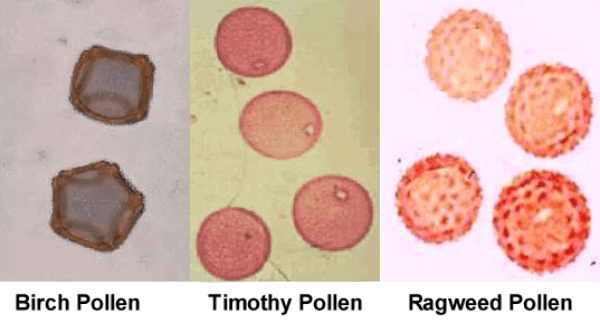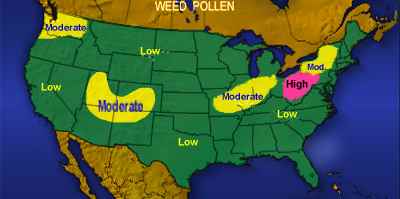 |
 |
| Home | Welcome | What's New | Site Map | Glossary | Weather Doctor Amazon Store | Book Store | Accolades | Email Us |
 | |||||||||
Weather Almanac for August 2001AEROALLERGENS: MISERY BLOWIN' IN THE WIND
Airborne pollen and spores are the dominant cause of hay fever, technically termed allergic rhinitis. The chemical makeup of the pollen is the basic factor that determines whether a particular type is likely to cause hay fever. When these lightweight pollens enter our noses and throats, they may trigger those allergic reactions characteristic of hay fever. In more severe reactions, lungs become affected as well.  Light pollens, broadcast from trees, grasses and weeds on the wind, are the prime offenders for most sufferers. Pollens that are transferred from plant to plant -- generally those with colourful or fragrant flowers -- by bees and other insects can also be allergens, but they are generally too heavy to become effectively windborne and cause trouble only when a person comes into direct contact with the plant: literally when they do stop to smell the roses, etc. The name hay fever arose several centuries ago when most people lived and worked on farms. At haying time during late summer and autumn, many began to feel ill. Their noses ran, they sneezed terribly, and their eyes swelled, itched and watered. Most were convinced they had developed some feverish illness caused by the hay with which they were working, or perhaps by the hot weather. Finally in 1873, English researcher Charles Blackley correctly associated the illness with plant pollen. Hay fever and its springtime equivalent rose fever are not, however, really fevers since the sufferer does not usually run a temperature. But the names have stuck with us over the years. They are further misleading as hay has nothing to do with hay fever, nor roses with rose fever. However, we now use hay fever as the popular catchphrase to describe warm-weather, nose-and-eye allergy symptoms due to pollens and spores regardless of season or cause. Hay Fever SeasonsMany allergy sufferers have to contend with allergy symptoms during more than one season. Allergy seasons occur at different times of year, in part, because trees, grasses, and weeds produce pollens during different periods. Hay fever seasons are commonly divided into early spring, late spring/early summer and late summer/early autumn, depending on the region of North America and the local vegetation mix. Connection of seasons to specific months given here is most associated to sites in the northern US states and southern Canada. Seasons will often occur earlier in the Southern US and along the Pacific Coast and later in northern areas of Canada and at altitude.
Late summer/early autumn -- from mid-August until the first frost -- the true hay fever season is primarily attributed to ragweed and other "weed" species such as curly dock, lambs quarters, Russian thistle, pigweed, English plantain, sheep sorrel and sagebrush, which also pollinate profusely during this period. Cross reactivity among these weeds is high so an allergic reaction to one is almost certain to cause you to react to all.
Seasonal conditions for pollen formation can fluctuate from year to year depending on how the growing season for the various plants unfold across a region. In certain tree species, the formation of pollens can vary by as much as a month from one year to the next. For example, a cold or wet spring may delay pollination in some species by as much as several weeks. Similar variations can occur for those plants which require a set amount of accumulated heat before they initiate pollen development. The situation may even be getting worse for those allergic to ragweed pollens according to research by Lewis H. Ziska, a plant physiologist with USDA's Agricultural Research Service. He has shown that pollen released by ragweed plants grown in indoor chambers at various levels of atmospheric CO2, increased substantially in number as the gas concentration increased. Under early 1900 CO2 concentrations of 280 parts per million (ppm), today's 370-ppm concentration and a predicted future level of 600 ppm, ragweed pollen production rose from 5.5 grams to 10 grams to 20 grams, respectively. Hay Fever WeatherSince in all seasons hay fever-producing pollens and spores are disseminated by the wind, weather is an important factor in a sufferer's degree of discomfort. Fluctuations in air temperature, humidity, rainfall, wind and sun can affect the amount of pollen in the air. Thus, pollen concentrations as reported by the pollen count, the number of pollen grains of a particular species counted in a set volume of sampled air, vary from day to day and even hour to hour.
The pollen count will vary during the day as the diurnal weather cycle unfolds in concert with the production activity of the pollen producers. Early morning hours are often the worst time of day for hay fever sufferers as plants busily pump out pollen that accumulates in the still, stable surface air.
Pollen released throughout the day from surface sources such as grass and ragweed can thus rises high into the air and travel great distances from their source. As a result of good thermal mixing of surface air during the day, pollen concentrations can be high over large areas in the late afternoon and early evening. High pollen counts, however, often persist through the night. The pollen count may increase in the evening when the near-surface air cools, winds and vertical mixing decrease and the pollen aloft settles into the now-still surface air. (This can aggravate symptoms for those who sleep with bedroom window open, making for a miserable, sleepless night.) Tree pollens, in contrast to pollens from surface plants, can be wafted away at any time of day or night when the wind is strong enough to dislodge them. Windy days force more tree pollens into the air, but strong winds also dilute the pollen burden of the air as it moves away from the source region. In many cases, the onset of rain relieves pollen-induced symptoms, because rains literally wash the pollen out of the air. But the degree of relief can depend greatly on the timing of rain onset. Early morning rains may halt the release of pollens before they can become airborne. However, often just before a late-morning or afternoon rainstorm, pollen levels have been found to increase as the descending air around a raining cloud pushes pollen-laden air back toward the surface and decreases the mixing depth into which the pollen is emitted. If heavy rainfall follows, the pollens may thrn be cleansed from the air.
Large-scale weather patterns have quite important influences on measured pollen levels. High pollen counts are often found just after the passage of a cold front and again in the warm air flow moving up from the southern US states. In contrast, cold air masses originating in northern Canada, where pollen-producing species such as ragweed are low in number or absent, can often give sufferers a brief respite, at least until the air is again filled with locally produced pollens. Similarly, periods of extended rainfall around slow-moving warm fronts and low pressure centres may alleviate many hay fever symptoms by washing out pollens and spores.
Levetin and others have shown that such models can be useful in determining the long distance movement of pollens into an area. This knowledge, coupled with knowledge of plant life cycles, air mass and frontal positions, and local pollen counts can be used to alert those at most risk to hay fever attacks, especially if the pollen is from a non-native species or one not yet in bloom locally. Such information is used to produce the "allergy reports" seen in various media, such as The Weather Network in Canada and The Weather Channel in the US. Other commercial ventures (see end of article for a list of URLs) also produce weather/allergy reports based on the forecast weather conditions and knowledge of pollen release variations.  Pollen counts are also widely disseminated by local news media in many areas as a measure of potential discomfort by sufferers. But at times, they can be misleading, depending upon where and when the measurements are taken and the monitoring location relative to the sufferer, particularly if either the sufferer or measuring site is located near a field or stand of the offending plants. What Can You Do To Alleviate Symptoms?I was fortunate enough to outgrow my debilitating reaction to most pollens, and in my later years in the Great Lakes region, was only occasionally annoyed by hay fever. Now living on Vancouver Island, I am in a region where my prime nemesis Ragweed is not native. And although pollen-producing trees and grasses flourish in this climate, I do not react adversely to them. The ideal prescription for hay-fever suffers is to live away from areas where their allergy pollens are produced or transported. But that is often not feasible, so here are a few tips to help alleviate symptoms before being forced to reach for medication -- or the national real estate listings. Stay indoors if possible on hot and windy days during heavy pollen seasons, and keep windows and doors tightly closed. In many areas, home air-conditioning makes this an easy remedy. However, if you do not have home air-conditioning and the weather is too hot to keep windows and doors closed, try to spend as much time as possible in locations that are air-conditioned, such as schools, libraries, theaters, community centers and shopping malls. Offices and other workplaces are usually air-conditioned so hay fever season may be a good time to put in some extra hours. Spend time along the seashore or the shores of large lakes, such as the Great Lakes. These locations often provide relief when winds with low pollen burdens are blowing off them. Install an air purifier in central air conditioning systems or in one room where you can spend much of the day. Be sure to change the air filters in air conditioning systems and air purifiers frequently during the hay fever season. Reduce outdoor activities, particularly gardening and lawn mowing. If you must be outdoors, consider wearing a pollen mask (sold at most drugstores), especially when mowing grass because a lawn mower creates a cloud of hay fever-producing pollens and spores as it is pushed along. Knowing when pollen counts are the greatest for your particular sensitivities, you can better adjust your lifestyle and schedules. One good way is to follow the media pollen forecasts and develop a weather eye for specific conditions that produce your greatest discomfort. Awaiting First Frost"The winds of August are particularly painful to some people, not because they are winds but because they are laden with pollens." wrote Hal Borland in Sundial of the Seasons. "So August winds, even cool winds, have their unwelcome aspects, from which neither city or country escapes." After emptying the fifth box of tissues in a week and having your voice unpleasantly altered due to stuffed sinuses, the chronic hay-fever sufferer cannot wait "undill de fir't frodzt." For many, that first killing frost is seen as a hero -- Jack Frost The Liberator -- from seemingly endless days of misery...unless, of course, you are also burdened with mold/mildew sensitivities. For more information on hay fever weather and current pollen reports, visit the following websites:
Written by
|
|||||||||
 |
To Purchase Notecard, |
Now Available! Order Today! | |
 |
 |
NEW! Now |
The BC Weather Book: |


